 |
 |
 |
 |
 |
 |
 |
 |
 |
 |
|
KICP Workshops & Events
|
Space Explorers 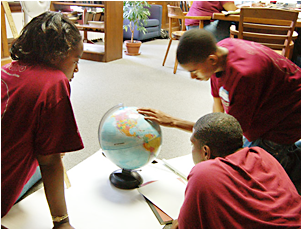 Please contact Ted Ressell, the KICP Assistant Director, with any ideas, comments, or questions about the Institute's efforts. Demystifying everyday electronics, Yerkes Winter Institute December 27 - 29, 2017 | Yerkes Observatory, Williams Bay, WI  This year in YWI we will explore how everyday electronics work. Through the analogy of waves on a string, students will explore the principles behind wireless transmission. Demos of the Faraday experiment will illustrate the conversion between electricity and magnetism, building an intuition for circuit elements. These mini-activities will lead students into building three functional electronic devices used in everyday life -- the microphone, speaker and AM radio. Using the devices they built, students will modify components of their device such as the capacitance on the radio, or the strength of magnet used in the speaker in order to alter the radio channel or the loudness of the speaker. These experiments are designed to engage the students' interest in the physics of everyday electronics. Related Links: KICP Members: Richard G. Kron; Brian Nord KICP Students: Andrea Bryant; Zoheyr Doctor; Philip Mansfield The Physics of Toys, Yerkes Summer Institute July 30 - August 5, 2017 | Yerkes Observatory, Williams Bay, WI 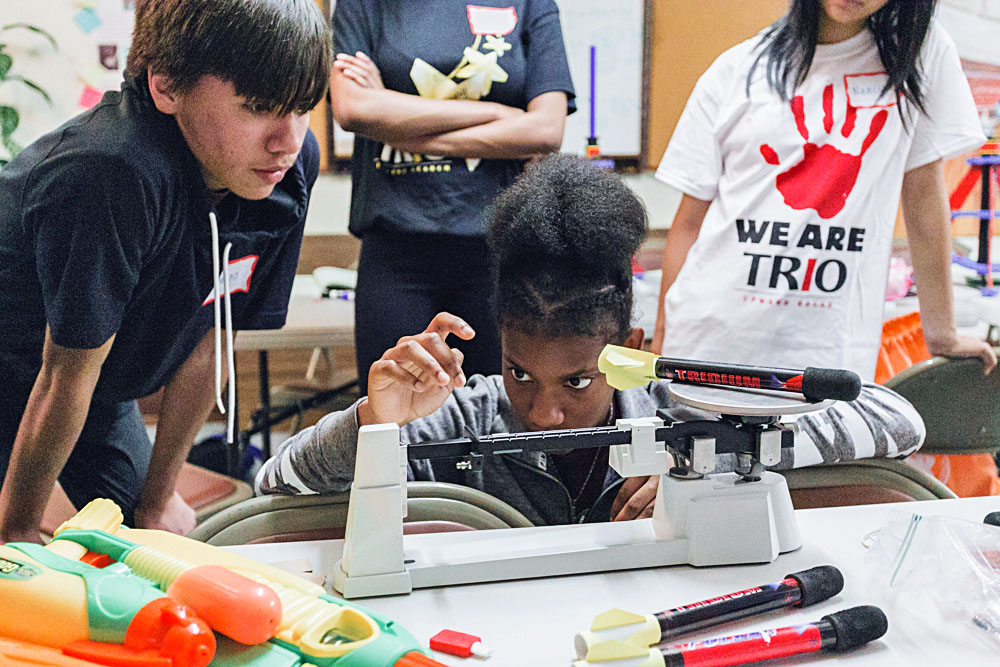 Over the course of a week, local Chicago high school students will learn about how the physics of energy conservation makes various everyday toys possible, and how using a structured engineering design process can allow them to understand the inner workings of things around them. In the three main labs, students will learn about pressure potential energy by reverse engineer super soakers and testing manufacturer claims about bottle rockets, they will learn about elastic potential energy by building and racing wind up cars, and they will learn about gravitational potential energy as they compete to build room-sized Rube Goldberg machines. The Institute will also contain various bite-sized activities, ranging from observing nebulae with the Yerkes 24-inch telescope, to learning defense techniques against deceptive infographics, to investigating the mysterious physics of the household microwave. Related Links: KICP Members: Jason Henning; Randall H. Landsberg KICP Students: Zoheyr Doctor; Gourav Khullar; James Lasker; Philip Mansfield; Nora Shipp Up & Down, Yerkes Winter Institute December 27 - 29, 2016 | Yerkes Observatory, Williams Bay, WI 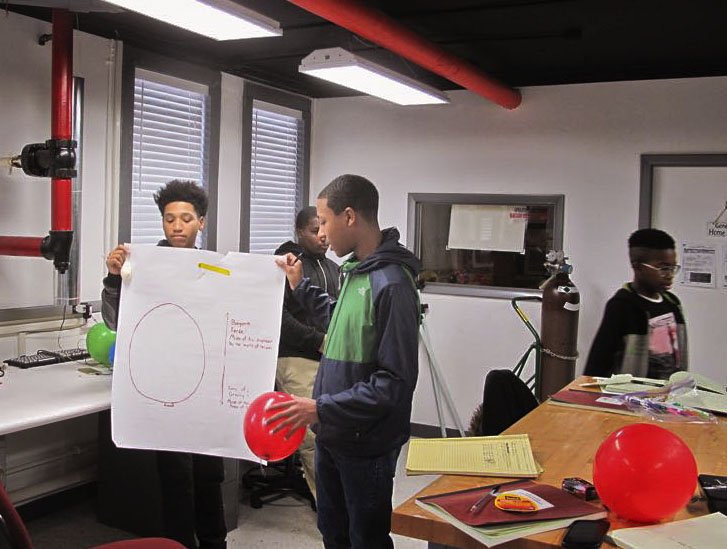 Instructors: Randy Landsberg, Phil Mansfield, Eric Oberla, and Erik Shirokoff. The 2016 Yerkes Winter Institute (YWI) focused on the forces that lift objects up and what happens when they are pushed down. Twenty local high schoolers in the Space Explorers program participated in three labs led by Erik Shirokoff, Eric Oberla, Phil Mansfield, and Randy Landsberg, which focused on pressure and buoyancy. This year's activities included weighing a car using only an air pressure gauge and a sheet of paper, determining how many party balloons it would actually take to lift the house in the film Up! (or the ANITA experiment), and a camp-wide competition where students used Archimedes' Principle to design boats that could carry as many pennies as possible. The activities in this year's YWI will help prepare the Space Explorers for the launch of a high altitude balloon which they will be performing later in the year. Nighttime activities included observations with the 24-inch telescope, identifying constellation and interesting astrophysical objects that they contain, and a slide show of the recent launch of ANITA in Antarctica. Thirty-seven parents and siblings joined the last day of YWI for presentations and closing ceremony. Related Links: KICP Members: Randall H. Landsberg; Eric Oberla; Erik Shirokoff KICP Students: Philip Mansfield Spy vs. Spy, Yerkes Summer Institute August 3 - 9, 2016 | Yerkes Observatory, Williams Bay, WI 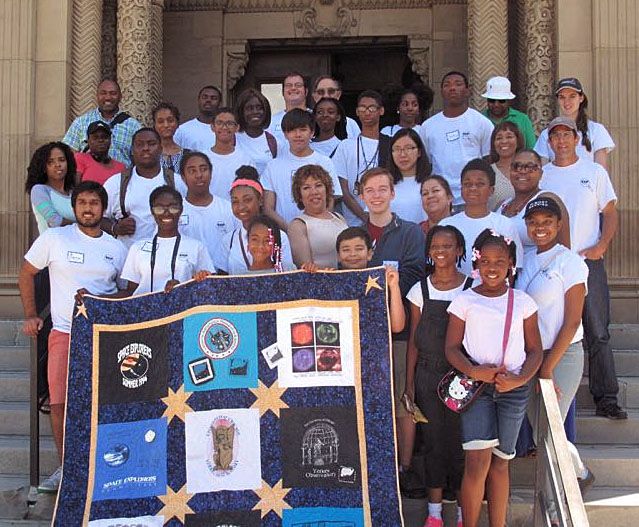 Instructors: Camille Avestruz, Zoheyr Doctor, Gourav Khullar, Richard G. Kron, Randall H. Landsberg, James Lasker, Phil Mansfield, Sam Passaglia, Rebecca Pierce, Jason Poh. The 2016 Yerkes Summer Institute (YSI) was filled with secrecy, deception, and espionage. At YSI, high school students in the Space Explorers program played the role of 20th-Century spies to handle secret information: revealing, concealing and distorting information. Through three day-long lab activities, the students explored connections between spying and science. In the "Secret Photos" lab, they studied angular size, resolution, and the film-development process in order to effectively gather information on "enemy operatives" using 35 mm cameras. In the "Radio Beams" lab, students designed, built, and tested a system to transmit audio via an amplitude-modulated (AM) laser, which allowed them to secretly communicate across long distances. Lastly, techniques to securely communicate were examined in the "Codes and Ciphers" lab, which also served as an introduction to modern cryptography. After cycling through these three day labs, the students broke into three new groups and took one of the labs a step further: one group doctored photographs to spread false information, another built AM radio transmitters and receivers, and the last created treasure hunts using codes and ciphers for the clues. Nighttime activities included: observations with the Yerkes telescopes, astrophotography, explorations of the constellations which focused on what current research can tell us about them (e.g. most know exoplanets were found by Kepler in the constellation Cygnus); and bad weather activities that included examinations of the veracity of viral internet photos, and stories of famous spies. The week's spy-themed activities not only introduced the students to the importance of privacy in the digital age, but also to the concepts and skills that are integral to any modern STEM career. Related Links: KICP Members: Camille Avestruz; Richard G. Kron; Randall H. Landsberg KICP Students: Zoheyr Doctor; Gourav Khullar; James Lasker; Philip Mansfield; Jason Poh The Science of Musical Instruments, Yerkes Winter Institute December 27 - 29, 2015 | Yerkes Observatory, Williams Bay, WI 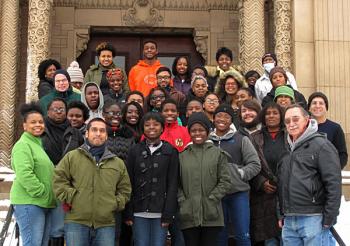 Instructors: Cosmin Deaconu, Zoheyr Doctor, Brittany Kamai, Randy Landsberg, Rito Basu Thakur. At this Yerkes Winter Institute, we will explore the connections between musical instruments and the physics of sound. Students will build their own pan flutes, drums, and synthesizers to learn about the principles that drive instrument design and construction. With homemade instruments in hand, students will examine how physical parameters and playing techniques affect sound and quality (i.e., frequency and time domain waveforms produced by their instruments). Related Links: KICP Members: Ritoban Basu Thakur; Cosmin Deaconu; Randall H. Landsberg KICP Students: Zoheyr Doctor; Brittany Kamai Mission to Mars: Engineering Design Process, Yerkes Summer Institute August 2 - 8, 2015 | Yerkes Observatory in Williams Bay, WI  Instructors: Louis Abramson, Ross Cawthon, Zoheyr Doctor, Dylan Hatt, Chen He, Sean Johnson, Randy Landsberg, Jason Poh. Tonight we will begin a week of engineering and exploration. Throughout the week, we will tackle a number of engineering challenges associated with exploring a distant planet: Mars. After this week of working in teams, defining problems, brainstorming, building, testing, and improving your designs, you will make a presentation to your family and fellow students about what you did and learned. Below, we describe the institute schedule and format so you can better plan for the week ahead. The institute will kick-off with a star party hosted by the Milwaukee Astronomical Society (MAS) on Sunday night. During the day on Monday, Tuesday, and Wednesday we will focus on three daytime laboratories, each of which explores a different engineering challenge associated with exploring the surface of Mars: Robotic Manipulation, Extraterrestrial Navigation and Launching/Landing (see lab summary descriptions on page iii). You will be divided into three groups named after past Mars missions: VIKING, PATHFINDER, and CURIOSITY. Each group will devote an entire day to each daytime lab, but the groups will cycle through the labs in a different order. By the end of the day on Wednesday, each group will have performed all three of the day labs. Related Links: KICP Members: Randall H. Landsberg KICP Students: Louis Abramson; Ross Cawthon; Zoheyr Doctor; Dylan Hatt; Chen He Heinrich; Sean Johnson; Jason Poh Robotics, Telescopes and S.T.E.A.M., Yerkes Winter Institute December 27 - 29, 2014 | Yerkes Observatory, Williams Bay, WI 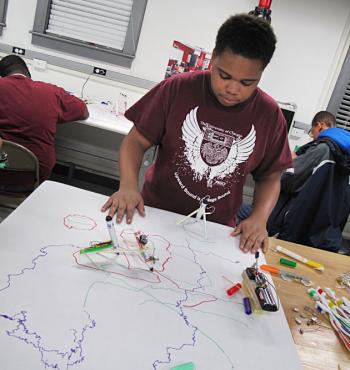 Instructors: Julieta Aguilera, Walter Glogowski, Chen He, Randy Landsberg, Ian Remming, Ted Ressel, Richard Saldanha, Erik Shirokoff, Alanna Simone. The Yerkes Winter Institute (YWI) is a three-day residential science immersion experience held at the historic Yerkes Observatory in Williams Bay, Wisconsin. It offers high school students in the Space Explorers Program the chance to delve into STEM (Science Technology Engineering and Math) through experiments, nighttime telescope observing and by working side-by-side with practicing scientists. YWI 2014 continued the year-long theme of robotics, building on the fall quarter work on mechanics (e.g., levers and gears), and seeding the winter/spring quarter projects which will focus on programming and engineering challenges. The students cycled through three daytime labs in small groups devoting over three hours to each lab. Two labs utilized "Sphero", a small spherical commercial robot that can be programmed to move and display colors. One involved programming a Sphero to navigate a maze, while the other used them as a remote probe of surface variations, similar to how a robot might explore the surface of a distant planet. In the third lab the Space Explorers constructed simple insect-like bug-bots and engineered them to compete in a sprint and bot Sumo wrestling. Evening activities included observing with the Yerkes telescopes and two creative S.T.E.A.M (Science Technology Engineering ART and Math, or STEM + Art) projects. Both involved using technology to make art, the first with long camera exposures and Sphero's controllable lights and the other with bug-bots and more traditional media (i.e., pens and paper). Celestial art was examined with the 24-inch telescope, which was used to observe distant red giant stars and star clusters. In addition to OSP staff, there were nine instructors: three senior members of KICP, an Adler Planetarium & Astronomy Museum staff member, a postdoctoral fellow, a public school teacher, an artist, and two graduate students. The Yerkes Winter Institute is one of two annual residential science immersion experiences that the Space Explorers participate in - the 2015 Yerkes Summer Institute is scheduled for August 2-8, 2015. Related Links: KICP Members: Randall H. Landsberg; M. Ted Ressell; Richard Saldanha; Erik Shirokoff KICP Students: Chen He Heinrich Renewable Energy: Back to the Sun, Yerkes Summer Institute August 10 - 16, 2014 | Yerkes Observatory, Williams Bay, WI 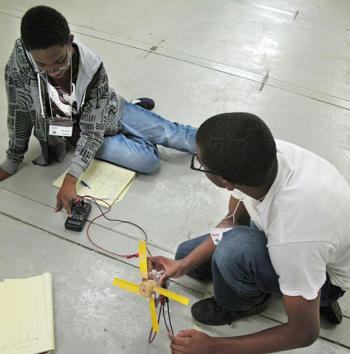 Instructors: Louis Abramson, Andrew Belcher, Walter Glogowski, Chen He, Ross Cawthon, Randy Landsberg, Samuel Meehan, Kyle Story, and Kat Ziegler. The 2014 KICP Yerkes Summer Institute explored different aspects of renewable energy. The "Biofuels: The Green Machine" lab investigated photosynthesis as well as producing biodiesel and ethanol. The "Catching Sunlight: Solar Cells" laboratory involved the students constructing solar cells that utilized berry juice and then testing the effects of lighting conditions on the electricity production of commercial photovoltaic cells. "A Wind Ensemble: Motors and Generators" explored the construction of horizontal axis wind turbines and Savonius turbines and then hydroelectric generators. Evenings were devoted to examining the night sky with the observatory telescopes and to a game of energy Jeopardy. Related Links: KICP Members: Randall H. Landsberg KICP Students: Louis Abramson; Ross Cawthon; Samuel Meehan; Kyle Story; Kat Ziegler Transforming Energy, Yerkes Winter Institute December 27 - 29, 2013 | Yerkes Observatory, Williams Bay, WI 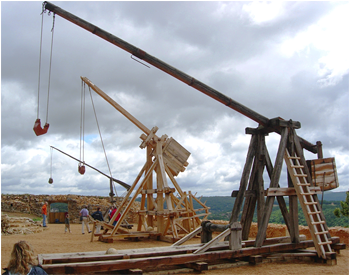 Related Links: KICP Members: Keith Bechtol; Juan I. Collar; Randall H. Landsberg; Tongyan Lin; M. Ted Ressell KICP Students: Samuel Meehan Colors Answers, Yerkes Summer Institute August 4 - 10, 2013 | Yerkes Observatory, Williams Bay, WI 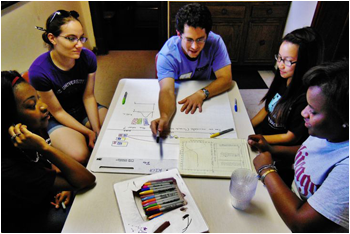 Instructors: Louis Abramson, Ross Cawthon, Dylan Hatt, Sean Johnson, Randy Landsberg, Samuel Meehan, Sean Mills, Kyle Story, Kat Ziegler The Yerkes Summer Institute (YSI) is a week long, residential, science camp for inner-city high school students in the Space Explorers Program. In addition to providing the students a science immersion experience, it offers many teaching, curriculum design, communications and team working opportunities for the instructors, who are generally early career scientists. YSI 2013 focused on the information content of color as an investigative tool. In each lab, students applied a different type of spectrometer to measure the wavelength or, roughly-speaking, color components of light in order to identify the composition of unknown objects or substances. During the first part of the week, students cycled through three different day-long laboratories, which focused on color vision, food color dyes, and stellar spectra. These daytime activities led to two days of extension activities in which groups of students investigated in greater depth one of the labs and prepared a presentation on their findings for their parents and peers. Nighttime activities focused on observations with the Yerkes Observatory telescopes and creation of colorful art. In "Seeing Color", students learned how color vision is the measurement of a wavelength spectrum by the eye. Students tested the usefulness of the eye as a spectroscopic tool by creating red-green-blue (RGB) histograms of low-resolution images to uniquely identify objects and pictures. In the conclusion of the laboratory, students recreate the process of color vision by applying RGB filters to produce a number of black and white photographs, which were then recombined with false color to form color images. The "Liquid Colors" lab discovered the properties of absorbance and transmittance for common FD&C dyes (e.g., Blue No. 1) using visible light spectrometers, Spectronic-20's, and then applied that knowledge to identify the composition of common colored beverages (e.g., Gatorade). During the "Barcoding the Stars" lab, students built their own spectrographs to observe the unique spectral signature of elements here on Earth in gas discharge lamps. After gaining an understanding of basic atomic physics, students used standardized spectra to identify the composition of stars. Related Links: KICP Members: Randall H. Landsberg KICP Students: Louis Abramson; Dylan Hatt; Sean Johnson; Samuel Meehan; Kyle Story Vision, Yerkes Winter Institute December 27 - 29, 2012 | Yerkes Observatory, Williams Bay, WI 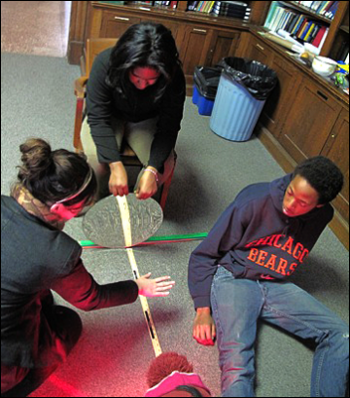 Lab Instructors: Dylan Hatt, Alissa Bans, Juan Collar, Walter Glogowski, Randy Landsberg, Tongyan Lin, Sean Mills, and Denis Erkal (lab development). The 2012 Yerkes Winter Institute focused on the eye and how the world is perceived through vision. Three daytime laboratories that explored different aspects of human vision formed the core of the institute:
Nineteen (19) Space Explorers and seven (7) instructors were in residence at the Institute, and thirty-five (35) parents, siblings and family members joined the last day of the institute for the student presentations and the closing ceremony. Participant Survey Excerpts: 94% of participants would recommend it to their friends
YWI 2012 "Vision" - Laboratory Descriptions:
Related Links: KICP Members: Juan I. Collar; Randall H. Landsberg; Tongyan Lin KICP Students: Alissa Bans; Denis Erkal; Dylan Hatt Making & Breaking: Destructive Testing , Yerkes Summer Institute August 5 - 11, 2012 | Yerkes Observatory, Williams Bay, WI 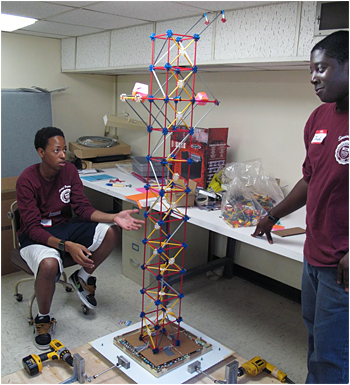 Instructors: Alissa Bans, Juan Collar, Nicole Fields, Dylan Hatt, Sean Johnson, Chris Kelso, Randy Landsberg,Reid Sherman, Kyle Story. The Yerkes Summer Institute (YSI) is a week long, residential, science camp for inner-city high school students in the Space Explorers Program. In addition to providing the students a science immersion experience, it offers many teaching, curriculum design, communications and team working opportunities for the instructors, who are generally early career scientists. YSI 2012 explored destructive testing as a tool for understanding stress, strain, and safety devices. In each lab, students studied the basic physics underlying a device, designed their own device, and then employed destructive testing to improve their designs. Monday through Wednesday, students cycled through three different day long laboratories, which examined bridge failure, crash tests, and the effects of earthquakes on structures. These daytime activities lead to two days of extension activities in which groups of students further investigated a lab and prepared a presentation on their findings for their parents and peers. Nighttime activities focused on observations with the Yerkes Observatory telescopes. In the "Spanning the Gap: Bridges" lab students studied the fundamentals of bridge design, especially how bridges accommodate loads (static stresses). They designed and constructed their own bridges, which they then stress tested by loading with progressively more weight, until they failed. Finally, the students applied what they had learned from the failure modes to build better bridges. The "Humpty Dumpty: Crash Test" lab investigated the extreme stresses that occur during a car crash using a pinewood derby car with an egg as a proxy for a passenger. After exploring impact stress, stopping distances, deceleration and how seat belts, airbags and crumple zones lessen damage, the students designed safety devices to protect an egg during a derby car crash test. Although none of the initial student designs were successful, by experimenting with different seatbelt and airbag configurations, the students iteratively improved their designs until they were able to keep their egg passengers safe. During the "Quaking Towers: Shake Table" lab, students investigated strategies employed to help buildings withstand the powerful dynamic stresses of an earthquake. They then designed and constructed "earthquake resistant" model sky-scrappers, using an evolved form of Tinker Toys called K'nex. These model buildings were tested on a homemade shake table, which simulated earthquake conditions. The dynamic stress tests were documented via video, and careful frame-by-frame analysis helped the students to determine where and how their buildings had failed, which lead to improved designs. Participant Survey excerpts: 77% felt there were connections between the Yerkes labs and everyday life (e.g., I usually don't wear seatbelts, now I understand why its important to wear it.) 94% would recommend this institute to their friends
Related Links: KICP Members: Juan I. Collar; Randall H. Landsberg KICP Students: Alissa Bans; Nicole Fields; Dylan Hatt; Sean Johnson; Christopher M. Kelso; Kyle Story Up!: Thrust, Buoyancy, and Drag, Yerkes Winter Institute December 27 - 29, 2011 | Yerkes Observatory in Williams Bay, WI 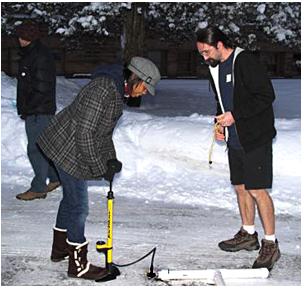 The 2011 Yerkes Winter institute focused on things that float and fly: rockets and balloons. The students found scaling relations in order estimate the answer to questions such as:
Instructors: Alissa Bans, Nicole Fields, Walter Glogowski, Sean Johnson, Christopher Kelso, Randy Landsberg, Amol Upadhye. Related Links: KICP Members: Randall H. Landsberg; Amol Upadhye KICP Students: Alissa Bans; Nicole Fields; Christopher M. Kelso Detectors/Super Sensing, Yerkes Summer Institute August 7 - 13, 2011 | Yerkes Observatory, Williams Bay, WI 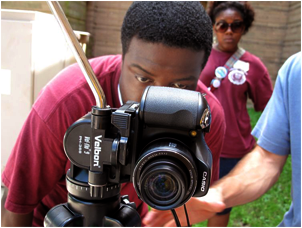 The 2011 Yerkes Summer Institute focused on detectors and the impact these devices have had in enhancing humanity's ability to understand the universe. Taking traditional photography, high-speed and time-lapse photography, and active sonic imaging as examples, students spent a week exploring how these technologies have extended human memory, opened the time domain, and illuminated the world at beyond-visual-range. Over the course of the institute, students built their own detectors and learned to interpret their detections. They gained a hands-on understanding of how their instruments worked and came to grips with fundamental questions regarding the relationships between inputs and outputs and the distorting effects of error. Related Links: KICP Members: Randall H. Landsberg Surface Area, Yerkes Winter Institute December 27 - 29, 2010 | Yerkes Observatory in Williams Bay, WI 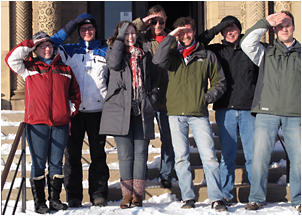 The 2010 KICP Yerkes Winter Institute explored the importance of surface area. Over three days, students cycled through three daytime laboratories ranging from a parachute experiment, "What a Drag", to the basics of friction, "Slip Sliding Away", to the influence of surface area on reaction rates, "Plop Plop Fizz Fizz...". Nighttime activities included exploring the wonders of the winter sky by hunting for constellations, satellites, and planets using both naked eyes and binoculars. The birth and evolution of stars were also investigated by observing the Pleides and the Orion Nebula with the 24-inch telescope. While, another evening lab explored the importance of "collisional cross sections," in physical, chemical, and even astronomical reactions by examining the concept of cross sections via a kinesthetic learning experience, aka a snowball fight. The instructors in residence included five KICP graduate students and a public school teacher, another half dozen KICP member helped to design experiments and plan the institute. Instructors: Louis Abramson, Alissa Bans, Immanuel Buder, Matt Bayliss, Nicole Fields, Walter Glogowski. Related Links: KICP Students: Louis Abramson; Alissa Bans; Matthew B. Bayliss; Immanuel Buder; Nicole Fields Simple Machines, Yerkes Summer Institute August 7 - 13, 2010 | Yerkes Observatory in Williams Bay, WI 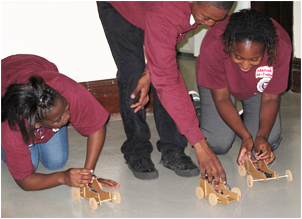 The 2010 KICP Yerkes Summer Institute was all about "work" and understanding the fundamentals and applications of Simple Machines. In the "Lift" lab the students learned about the physics of work against gravity with pulleys and a block and tackle. The "Trebuchet" lab was an examination of the physics of the lever and more, as it involved the construction of individual popsicle-stick sized trebuchets and a modest scale (~10 foot) modern siege machine. The "Gears" lab delved into mechanical advantage and disadvantage, how to calculate them, and how to apply them in the real world. The nighttime activities focused on observing the night sky with the naked eye, binoculars and the observatory telescopes as well as using gears to track celestial objects for astrophotography and capturing images on a research grade CCD. The institute culminated with student presentations to parents and peers. Each of three reporting groups made a presentation about the laboratory that they had spent two additional days (12 hours) of extension activities exploring. As well as the high school participants, nine (9) young KICP scientists gained valuable teaching, team-working and communications skills planning and executing this week long, science immersion experience. Instructors: Louis Abramson, Alissa Bans, Matt Bayliss, Kyle Cudworth, Nicole Fields, Vivian Hoette, Florin Ionita, Chris Kelso, Yeunjin Kim, Rich Kron, Randy Landsberg, Melanie Simet, Kyle Story. Related Links: KICP Members: Richard G. Kron; Randall H. Landsberg KICP Students: Louis Abramson; Alissa Bans; Matthew B. Bayliss; Nicole Fields; Florin Ionita; Christopher M. Kelso; Yeunjin Kim; Melanie Simet; Kyle Story Exploring the Solar System, Yerkes Winter Institute December 27 - 29, 2009 | Yerkes Observatory in Williams Bay, WI 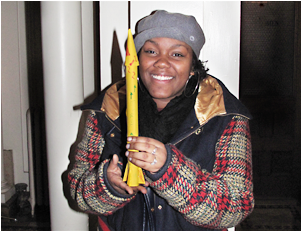 The three day, residential, 2009 KICP Yerkes Winter Institute was about exploring. Building on conversations earlier in the year with UC alumnus and NASA astronaut, John Grunsfeld, the "Rocket Lab" involved basic concepts of rocket science with the students designing constructing, testing, and improving their own compressed air paper rockets. In "Orientations of the Solar System" they explored how the motions and positions of the Earth-Moon-Sun system lead to the seasons, sunsets, eclipses, moon phases, and more. Finally in "Modeling the Solar System" the Space Explorers constructed two different scale models to understand the relative distances and sizes of the planets. Evening activities investigated planets beyond our solar system, exoplanets. The 24-inch telescope was used for a transit technique experiment and a computer based orbital motion simulator was employed to demonstrate how astrometry is used to detect a planet orbiting a distant star. Instructors: Alissa Bans, Nicole Fields, Walter Glogowski, Chris Kelso, Randy Landsberg, Kyle Story. Related Links: KICP Members: Randall H. Landsberg KICP Students: Alissa Bans; Nicole Fields; Christopher M. Kelso; Kyle Story The Physics of Sound, Yerkes Summer Institute August 1 - 7, 2009 | Yerkes Observatory in Williams Bay, WI 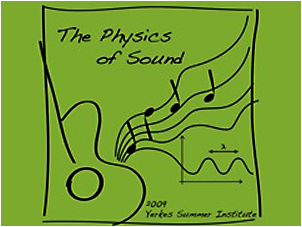 The unifying theme of the 2009 KICP Yerkes Summer Institute was "Sound". During an immersive, week long, science camp the Space Explorers, inner-city Chicago Public School students, investigated many aspects of sound. Day long laboratory activities included: constructing and analyzing musical instruments, measuring the speed of sound and examining the wave nature of sound. Evening experiments included viewing the night sky with the observatory telescopes, an investigation into the directionality of hearing including how certain animals excel at it, and the oral tradition of creating stories about constellations. YSI, as always, is an exceptional experience due to the instructors, who taught at Yerkes and worked together months in advance to plan and develop the institute. The instructional staff in residence included eight (8) graduate students, three (3) post docs and five (5) senior people. Instructors: Alissa Bans, Matt Bayliss, Brad Benson, Kyle Cudworth, Nick Halmagyi, Vivian Hoette, Chris Kelso, Yeunjin Kim, Rich Kron, Zosia Krusberg, Randy Landsberg, Sam Leitner, Reid Sherman, Jennifer Sobeck, Kyle Story, Phil Wisecup. Related Links: KICP Members: Bradford A. Benson; Richard G. Kron; Randall H. Landsberg; Jennifer Sobeck KICP Students: Alissa Bans; Matthew B. Bayliss; Christopher M. Kelso; Yeunjin Kim; Zosia Krusberg; Samuel N. Leitner; Kyle Story Cosmic Detectives, Yerkes Winter Institute December 27 - 29, 2008 | Yerkes Observatory in Williams Bay, WI 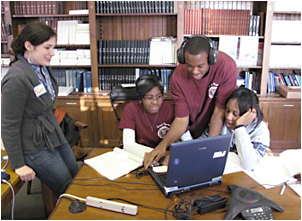 During the 2008 Yerkes Winter Institute (YWI) the Space Explorers became cosmic detectives and used their investigative skills to search for evidence, clues, correlations and other conclusions that could be drawn from "cosmic crime scenes". Eighteen (18) Space Explorers, one (1) Returning Scholar (i.e., a former Space Explorer acting as a junior instructor during their college break), and nine (9) laboratory instructors enjoyed snow filed investigations. "Hidden Messages" explored cryptography, "Footprints" examined the archetypal clue, a footprint, with the twist of electrostatic print lifting, and "Splat" examined a fairy tale catastrophe, Humpty Dumpty's fall combined with the physics of projectiles. Nighttime sleuthing activities included telescope observations of "hidden messages" in the Orion Nebula, determining which objects emit their own light via binoculars and deduction, and a giant puzzle of Sloan Digital Sky Survey data of the Andromeda galaxy (M31). Instructors: Alissa Bans, Matt Bayliss, Charles Brass, Kyle Cudworth, Bill Fisher, Robert Friedman, Nick Halmagyi, Vivian Hoette, Florin Ionita, Jon Jezak, Chris Kelso, Yeun-Jin Kim, Rich Kron, Zosia Krusberg, Randy Landsberg, Reid Sherman, Chris Thom, Amol Upadhye, Phil Wisecup. Related Links: KICP Members: Richard G. Kron; Randall H. Landsberg; Chris Thom; Amol Ravindra Upadhye KICP Students: Alissa Bans; Matthew B. Bayliss; Robert Friedman; Florin Ionita; Christopher M. Kelso; Yeunjin Kim; Zosia Krusberg Energy Transformations, Yerkes Summer Institute August 2 - 8, 2008 | Yerkes Observatory in Williams Bay, WI 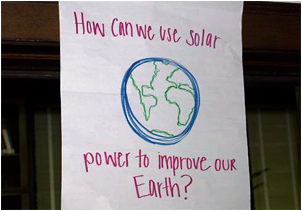 This week long, residential, science immersion experience investigated how energy is used and transformed. Three day long laboratories, which the students cycled through in small groups, each explored energy transformations. "Some Like it Hot" examined energy transfer from fundamental physics to applications of energy transfer in everything from home energy efficiency to energy transfer in ultra-energetic astrophysical events. "Solar Power" was about trapping energy from the sun and converting it into heat with solar ovens, into electricity with photovoltaic cells and into chemical energy via photosynthesis. "Turn the Crank" explored the inter-conversion of mechanical and electrical energy via generators/motors, windmills, bicycle generators, and a Rube Goldberg device. Evening activities explored the energetics of stars. One lab probed differences in colors and intensities of light from astronomical sources and how these properties relate to energy in binary, red giant and luminous blue stars. The other evening lab employed the 24-inch telescope to study a variety of nearby stellar systems and how energy production within these systems influences their immediate environments. The outstanding instructional staff was a mix of younger and more senior researchers as well as public school teachers. Twenty-three (23) Space Explorers, and nineteen (19) laboratory instructors participated in YSI 2008. Instructors: Alissa Bans, Matt Bayliss, Charles Brass, Kyle Cudworth, Bill Fisher, Robert Friedman, Nick Halmagyi, Vivian Hoette, Florin Ionita, Jon Jezak, Chris Kelso, Yeun-Jin Kim, Rich Kron, Zosia Krusberg, Randy Landsberg, Reid Sherman, Chris Thom, Amol Upadhye, Phil Wisecup. Related Links: KICP Members: Richard G. Kron; Randall H. Landsberg; Chris Thom; Amol Ravindra Upadhye KICP Students: Alissa Bans; Matthew B. Bayliss; Robert Friedman; Florin Ionita; Christopher M. Kelso; Yeunjin Kim; Zosia Krusberg Mapping Motion, Yerkes Winter Institute December 27 - 29, 2007 | Yerkes Observatory in Williams Bay, WI 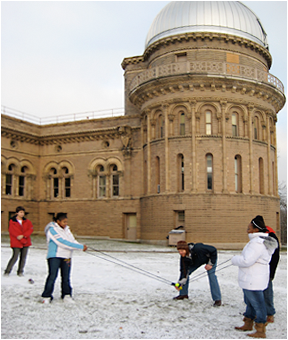 The unifying theme of 2007 KICP Yerkes Winter Institute was mapping motion. This theme extended KICP's participation in the citywide Festival of Maps and directly connected to the weekly, Saturday, on campus, explorations of gravity. YWI examined the force of gravity and the ways in which scientists use our understanding of gravity to map motions in the Universe. Twenty-one (21) Space Explorers, and seven (7) laboratory instructors participated in YWI 2007. The day laboratories explored different aspects of motion and gravity. "Shoot the Monkey" involved a classic trajectory lab with the addition of creating an accurate comic flipbook to depict the physics involved. "Galileo's Pendulum" examined what variables influence the motion of a pendulum and how a pendulum can function as a clock. "Weighing a Black Hole" combined basic orbital mechanics with recent observations of the motion of stars around the Galaxy's central black hole to calculate how massive it is. Evening activities included observing the night sky with binoculars, "Big Eyes", and a special presentation by KICP Visiting Scholar Joao de Mello about the Pierre Auger Observatory and its recent results on tracing the source of ultra-high energy cosmic rays back to activity caused by extremely massive black holes at the center of galaxies. Instructors: Charles Brass, Kyle Cudworth, Joao de Mello, Walter Glogowski, Vivian Hoette, Zosia Krusberg, Rich Kron, Randy Landsberg, Christopher Thom, Jeremy Tinker, Aurora Tyagi, Phil Wisecup. Related Links: KICP Members: Richard G. Kron; Randall H. Landsberg; Chris Thom; Jeremy Tinker KICP Students: Zosia Krusberg Mapping, Yerkes Summer Institute August 4 - 10, 2007 | Yerkes Observatory in Williams Bay, WI Website | Photo Gallery Scales, coordinate systems, contour maps, and multi-wavelength astronomy are just a few of the concepts that the Space Explorers delved into during the KICP Yerkes Summer Institute (YSI) under the overarching theme of "Mapping." YSI is a week-long, residential, science immersion experience for inner-city middle and high school students held at the historic Yerkes Observatory. A team that includes researchers from the University of Chicago, public school science teachers, and staff from the Office of Special Programs (OSP), our community partner, staffs the institute. The combination of pedagogical expertise, scientific expertise, interested students, and large blocks of time creates a memorable experience for everyone involved. The theme of YSI 2007, "Mapping," was inspired by the citywide Festival of Maps. Three daytime laboratories were developed for the institute to highlight different aspects of cartography. Mapping the Invisible investigated how astronomers use "invisible" colors such as infrared light to map and understand star-forming regions. Mapping the Yerkes Grounds involved students creating their own maps and testing their accuracy with a scavenger hunt. Projections explored elevation profiles and contour maps. The three nighttime laboratories: Mapping Nebulae in Multiple Wavelengths, Constellations, Determining the Structures of Galaxies, although somewhat dampened by rain this year, were also developed to fit the mapping theme. Instructors: Matt Bayliss, Charles Brass, Kyle Cudworth, Robert Friedman, Walter Glogowski, Nick Halmagyi, Sarah Hansen, Vivian Hoette, Rich Kron, Zosia Krusberg, Randy Landsberg, Sav Sethi, Chaz Shapiro, Reid Sherman, Ivo Seitenzahl, Chris Thom, Aurora Tyagi, Phil Wisecup, Benjamin White. Read more >> Related Links: KICP Members: Richard G. Kron; Randall H. Landsberg; Savdeep S. Sethi; Chris Thom KICP Students: Matthew B. Bayliss; Robert Friedman; Sarah M. Hansen; Zosia Krusberg; Charles Shapiro Scale of the Universe, Yerkes Winter Institute December 27 - 29, 2006 | Yerkes Observatory in Williams Bay, WI 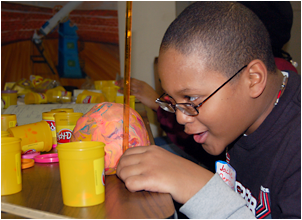 The unifying theme of 2006 KICP Yerkes Winter Institute was scale. This theme built directly upon the autumn quarter Saturday laboratory sessions, which focused on the methods by which distance is measured in astronomy. Twenty-six (26) Space Explorers, four (4) Returning Scholars (i.e., former Space Explorers helping during their college break) and nine (9) laboratory instructors participated in YWI 2006. The day laboratories explored the power of scale models for astronomical distances. "Seasonal Myth Busters" examined distances in the Earth-Sun-Moon system and the phases of the moon with the aid of a mechanical clockwork model, an orrery, and a kinesthetic exercise. "Planets: How Big? How Far?" gave the students a real sense of the dramatic scales and distances within the solar system. It explored the volumes of, and distances to, the planets using scale models that the students constructed out of Play-dough. "Milky Way Model" involved a construction project of massive proportions, billions of stars and hundreds of light-years in size. In the 90-foot dome, the students created a model of the Milky Way galaxy which provided valuable insights into polar coordinates and a deeper understanding of the astronomical information contained in the data (e.g., composition and nature of matter in the galaxy, the optical obstruction caused by cold, dense Molecular Clouds, and the necessity of making astronomical observations at many frequencies). Evening activities extended the concept of scale. Students took a digital tour of the universe that featured SDSS data. They observed the moon with the 24-inch telescope and binoculars and determined the size of key features such as the sea of tranquility. Finally, on a night with poor weather, they viewed the classic "Powers of Ten" movie. With financial support from the Office of the Vice President for Research and with the support of the Dean of the Humanities Division, a new written and verbal communication component was added. This effort sought to improve communication skills by developing reading, writing and oral exercises, which are complimentary and connected to the student scientific investigations. This component was lead by an anthropology graduate student, who met with the students on campus after Saturday Labs and who also integrated writing activities into the 2007 Yerkes Summer Institute with pre-institute readings and BIG Questions expository writing exercises. Instructors: Matt Bayliss, Mary Beard, Charles Brass, Kyle Cudworth, Bill Fisher, Robert Friedman, Walter Glogowski, Sarah Hansen, Vivian Hoette, Rich Kron, Randy Landsberg, Dan Robertson, Chaz Shapiro, Reid Sherman, Phil Wisecup. Related Links: KICP Members: Richard G. Kron; Randall H. Landsberg KICP Students: Matthew B. Bayliss; Robert Friedman; Sarah M. Hansen; Charles Shapiro Sink or Swim? Exploring Buoyancy & Density, Yerkes Summer Institute August 5 - 11, 2006 | Yerkes Observatory in Williams Bay, WI 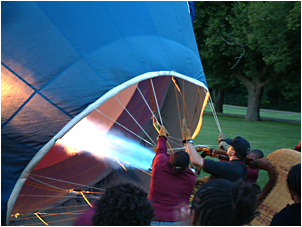 The theme of YSI 2006 was "Sink or Swim: Exploring Buoyancy & Density". Twenty-four (24) Space Explorers, thirteen (13) instructors and fifty (50) parents and siblings participated in this week long, residential, immersion experience. The institute was conceptually linked to the 2005-06 Saturday laboratory sessions, which explored pressure, especially air pressure. A memorable highlight of the institute was the in inflation and tethered launches of an actual 77,500 cubic foot hot air balloon. Daytime laboratories examined how density can be used to separate plastics for recycling, convection and how it results from changes in density caused by heating, and a qualitative investigation into what creates lift for a balloon. Nighttime activities included utilizing the observatory telescopes to examine dying stars, aka spectra of planetary nebulae and an exploration of the density of the moon to debunk the myth that it is made out of cheese. Instructors: Matt Bayliss, Mary Beard, Charles Brass, Kyle Cudworth, Bill Fisher, Robert Friedman, Walter Glogowski, Sarah Hansen, Vivian Hoette, Rich Kron, Randy Landsberg, Dan Robertson, Chaz Shapiro, Reid Sherman, Phil Wisecup. Related Links: KICP Members: Richard G. Kron; Randall H. Landsberg KICP Students: Matthew B. Bayliss; Sarah M. Hansen; Charles Shapiro Under Pressure, Yerkes Winter Institute December 27 - 29, 2005 | Yerkes Observatory in Williams Bay, WI 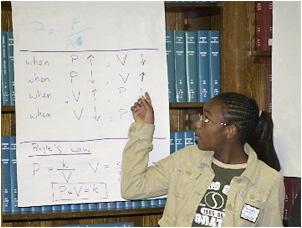 The unifying theme of the KICP's 2005 Yerkes Winter Institute was Air Pressure, which intentionally built upon the Saturday laboratory content. Twenty-eight students (28), twelve instructors (12), and fifty-two (52) parents, siblings, and younger students attended. Another three (3) researchers helped develop experiments. Each of the day labs explored a different aspect of air pressure concentrating on the relationships between pressure and volume. "Tired Pressure" was a clever experiment to weigh a car by measuring the pressure and the area of the footprint of each tire. "Kinetic Theory of Gases" constructed a conceptual model of the microscopic reasons for changes in pressure and volume caused by changes in temperature and particle number or size, first with a physical activity involving a canvas drop cloth and tennis and ping pong balls, and then with a computer simulation for more quantitative studies. This activity was presented by KICP graduate students at the 2007 National Science Teachers Association (NSTA) national meeting. "Boyles Law" provided a compelling direct physical understanding of the relationship between pressure and volume of a gas using a bathroom scale and 30 cc syringes plugged with epoxy. Evening YWI activities, although shorter, retained the pressure theme. "Potato Projectile & Hydraulic Spitballs" employed pressure as a means of launching projectiles in an ether fueled potato cannon and with syringes and wet paper towels a.k.a. hydraulic spitballs. "HAWC/SOFIA & Clouds Activity" related pressure and atmospheric complications for observational astronomy. Evening Telescope Observations were, unfortunately, canceled due to poor weather. Instructors: Charles Brass, Hsiao-Wen Chen, Kyle Cudworth, Tom Downs (lab developer), Bill Fisher, Walter Glogowski, Sarah Hansen, Vivian Hoette, Rich Kron, Randy Landsberg, Kathryn Miknaitis, Reid Sherman, John Vaillancourt, Phil Wisecup, Andrey Zhiglo. Related Links: KICP Members: Richard G. Kron; Randall H. Landsberg; Kathryn K. Schaffer KICP Students: Tom Downes; Sarah M. Hansen The Nature of Light, Yerkes Summer Institute August 6 - 12, 2005 | Yerkes Observatory in Williams Bay, WI  In honor of the World Year of Physics and the 100th anniversary of Einstein's "miraculous year", the theme of YSI 2005 was "The Nature of Light". Twenty-six (26) Space Explorers, twenty (20) instructors, and fifty (50) parents and siblings participated in this week long, residential, immersion experience. The institute reinforced concepts from the 2004-05 Saturday laboratory sessions, which explored the basics of light and its wave particle duality. A full six (6) hours was devoted to each day laboratory with twelve (12) additional hours allotted for extended investigations by small reporting groups. "The Photoelectric Effect" explored the quantum nature of light with physical model to demystify it and direct measurements of the photoelectric effect. "The Speed of Light" was a clever use of a television as a very fast detector that allowed the students to measure c to within twenty percent. "The Doppler Effect" explored the Doppler effect qualitatively with a buzzer on a string and then quantitatively by using a radar gun and a sound spectral analysis program to determine the frequency shift and its relation to speed. Evening laboratories included a study of quasar line broadening, related to the Doppler shift, the use of a CCD detector that was related to the photoelectric effect and finally an examination of supernova as standard candles. Instructors: Charles Brass, Lisa Blair, Kyle Cudworth, Tom Downes, Bill Fisher, Robert Friedman, Walter Glogowski, Sarah Hansen, Vivian Hoette, Dragan Huterer, Rick Kessler, Rich Kron, Randy Landsberg, Douglas Rudd, Chaz Shapiro, Matthew Sharp, Ivo Seitenzahl, Reid Sherman, John Vaillancourt, Phil Wisecup , Brian Wilhite. Related Links: KICP Members: Dragan Huterer; Richard Kessler; Richard G. Kron; Randall H. Landsberg KICP Students: Tom Downes; Sarah M. Hansen; Douglas H. Rudd; Charles Shapiro; Matthew Sharp Reflections, Yerkes Winter Institute December 27 - 29, 2004 | Yerkes Observatory in Williams Bay, WI 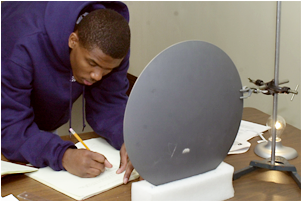 The 2004 KICP Yerkes Winter Institute was held on December 27-29 at Yerkes Observatory in Williams Bay, WI. (25 students, 10 instructors; 40 parents, siblings, and younger students attended). The theme of the 2004 Winter Institute was "Reflections", which built upon earlier explorations into the nature of light at the weekly Saturday Laboratories. The three daytime laboratories investigated reflections from flat and concave surfaces. The students empirically determined and tested the law of reflection (angle of incidence = angle of reflection); deconstructed a Newtonian telescope to understand how it works; and explored the power of collimating or beaming light and sound. Evening activities included utilizing the observatory telescopes and science lectures. Professor Rich Kron discussed galaxies and post-doc Brian Humensky lectured on gamma-ray astronomy. Instructors: Charles Brass, Bill Fisher, Robert Friedman , Walter Glogowski, Andrew Hill, Brian Humensky, Rich Kron, Randy Landsberg, Erin Sheldon, Phil Wisecup. Related Links: KICP Members: Brian Humensky; Richard G. Kron; Randall H. Landsberg; Erin S. Sheldon KICP Students: Robert Friedman What are stars made of?, Yerkes Summer Institute August 7 - 13, 2004 | Yerkes Observatory in Williams Bay, WI Website | Online Materials | Photo Gallery Between summer and the school year the Space Explorers joined members of the KICP at Yerkes Observatory in Williams Bay, WI for a week long investigation into spectroscopy structured around an organizing question, "What are stars made of?" This summer the Space Explorers investigated spectroscopy with the theme: What are stars made of? Through a series of related laboratory explorations the students delved into the fundamentals of spectroscopy and its application to astronomical objects. They studied an assortment of spectra from pure elements and pure food coloring dyes to complex mixtures in solar, stellar and galactic spectra. In some cases the challenge was to produce the spectra and in others to analyze it. Read more >> Related Links: KICP Members: Richard Kessler; Richard G. Kron; Randall H. Landsberg; Erin S. Sheldon; Monica Valluri KICP Students: Carlos E. Cunha; Robert Friedman; Christopher Greer; Sarah M. Hansen; Douglas H. Rudd; Matthew Sharp Phase Changes, Yerkes Winter Institute December 27 - 29, 2003 | Yerkes Observatory in Williams Bay, WI Website | Online Materials | Photo Gallery Participants: 28 students; 10 instructors; 35 parents, siblings, and younger students. The Yerkes Winter Institute is three-day science immersion program held each year between Christmas and New Years during a break in the Chicago Public School academic year. The institute exposes inner city middle and high school students to research scientists and to the process of science. During the institute students cycle among three daytime laboratories, evening experiments, lectures, and observing (weather dependant). The institute culminates with presentations by the students to their parents and younger students about the institute laboratories. The theme of the 2003 Winter Institute was Phase Changes, which was a natural extension of the weekly theme of temperature. Read more >> Related Links: KICP Members: Randall H. Landsberg; Thushara A. Perera; Savdeep S. Sethi KICP Students: Sarah M. Hansen; Andrew Puckett How Big is Our Universe?, Yerkes Summer Institute August 2 - 8, 2003 | Yerkes Observatory in Williams Bay, WI Website | Online Materials | Photo Gallery Participants: 28 students; 17 instructors; 50 parents, siblings, and younger students This year the Space Explorers tackled a core cosmological conundrum with the unifying theme of "How Big is Our Universe?" They explored this question in a variety of manners, from constructing model solar systems on the Yerkes grounds, to analyzing Sloan Digital Sky Survey data, which they used to build a distance ladder that stretched 6.5 billion light years. These interrelated activities helped to focus the students on the concept of determining astronomical sizes and distances. A number of pre-institute preparation sessions were held to motivate the investigations, and more practically, to develop needed skills. Topics ranged from a basic introduction to the components of the universe, to small angle approximations, to using software to measure apparent size. Students were also given a course booklet that contained an overview of the week, detailed schedules, and instructions for the different laboratory activities. Read more >> Related Links: KICP Members: Matthew Hedman; Daniel E. Holz; Richard G. Kron; Mark Subbarao KICP Students: Sarah M. Hansen; Jonathan Mitchell; Andrew Puckett Scaling Up, Yerkes Winter Institute December 27 - 29, 2002 | Yerkes Observatory in Williams Bay, WI Website | Online Materials | Photo Gallery The CfCP Yerkes Winter Institute is a three-day immersion program that allows middle- and high-school students to explore a scientific theme in depth under the guidance of Center researchers and educators. The theme for 2002 was Scaling Up, which encouraged the students to question how astrophysicists extrapolate simple measurements to understand the universe and its cosmic proportions. In the three daytime laboratories, students investigated everyday objects (balloons, sugar cubes, and light bulbs) and extended their results to more substantial things (the TopHat telescope, the 90-foot dome for the great refractor, and the sun itself). The students were divided into three groups that rotated among the daytime experiments, made nighttime observations, and shared their investigations with parents, siblings, and younger students who joined us at the end of the institute. Read more >> Related Links: KICP Members: Juan I. Collar; Randall H. Landsberg; Jonathan L. Rosner KICP Students: Andrew Puckett Radio Waves, Yerkes Summer Institute August 3 - 9, 2002 | Yerkes Observatory in Williams Bay, WI Website | Online Materials | Photo Gallery Participants: 24 students; 9 instructors; 80 parents, siblings, and younger students Radio Waves, the theme of 2002 YSI, builds upon the investigations that the Space Explorers had conducted during the spring when they constructed old fashioned crystal radio receivers. In addition to the spring laboratory experiences, the students were provided with background materials that helped to prepare them for the institute. After introductions and an overview of the week, the institute began with a Star Party hosted by amateur astronomers. The rest of the week was spent cycling through interrelated daytime laboratories in small groups, nighttime observations, peer discussions, and deeper explorations into each laboratory. The week culminated with student presentations that engaged their parents, siblings and younger students in the experiments that they conducted during the week, and a closing ceremony where certificates of accomplishment were presented. Read more >> Related Links: KICP Members: Matthew Hedman; Randall H. Landsberg KICP Students: Ryan Hennessy; Daisuke Nagai Sound Investigations, Yerkes Winter Institute December 27 - 29, 2001 | Yerkes Observatory in Williams Bay, WI Website | Photo Gallery Participants: 29 students; 9 instructors; 75 parents, siblings, and younger students The Yerkes Winter Institute is a three-day immersion program that allows students to explore one topic in depth. This year the topic was Sound, which built upon the autumnal laboratory investigations. The students rotated among three interconnected daytime experiments, made nighttime observations, and shared their investigations with parents, siblings and younger students who joined us at the end of the institute. The Yerkes environment provides a great contrast to the urban environment of Chicago. The institute is also a learning experience for the instructors. For example, by pairing classroom teachers with researchers, each partner can learn from the other's complementary skills. Read more >> Related Links: KICP Members: Randall H. Landsberg KICP Students: Ryan Hennessy |


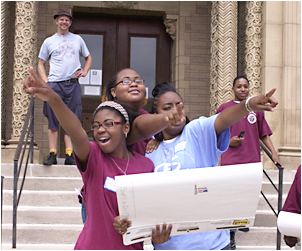
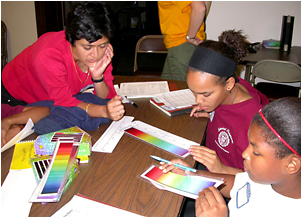
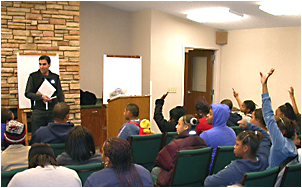
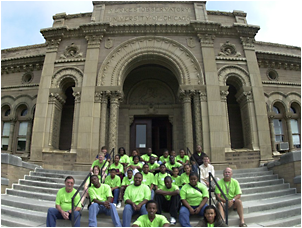
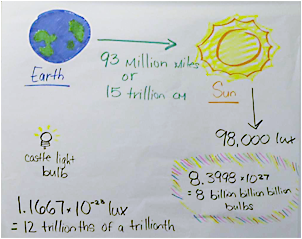
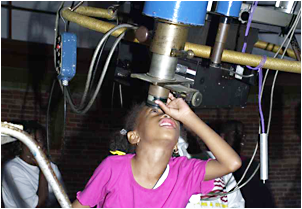
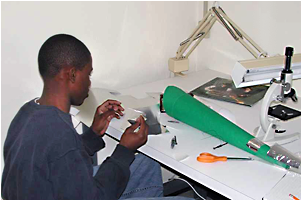



 Overview
Overview